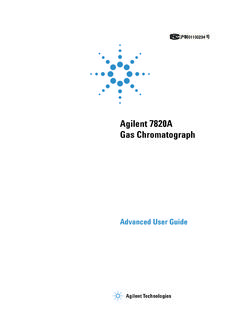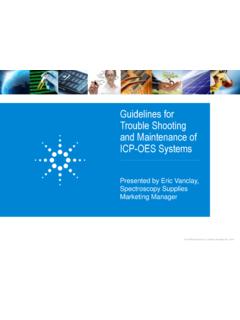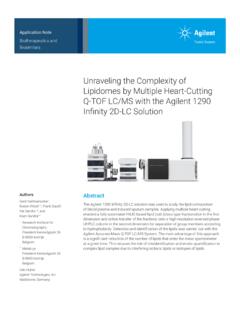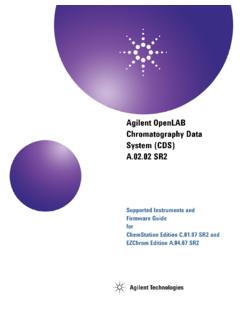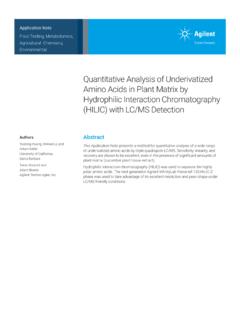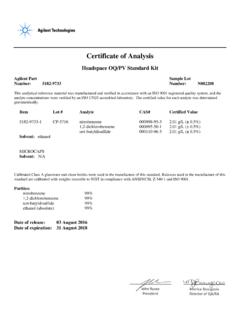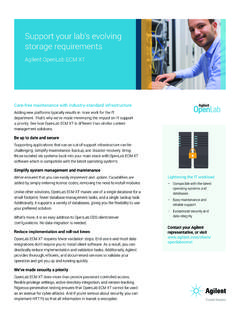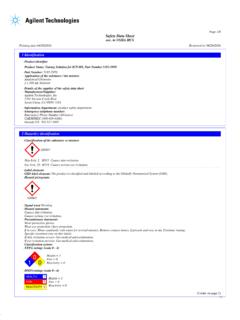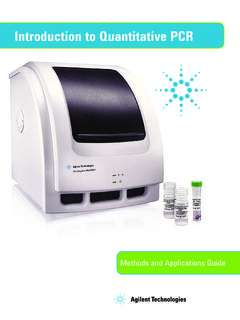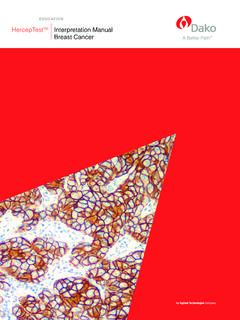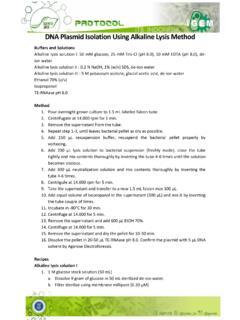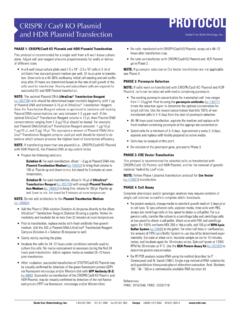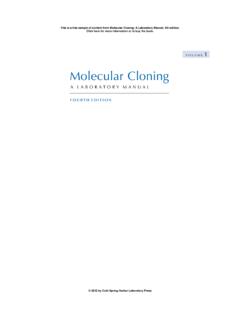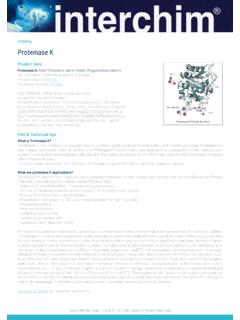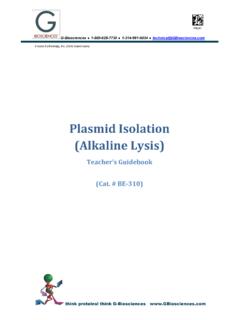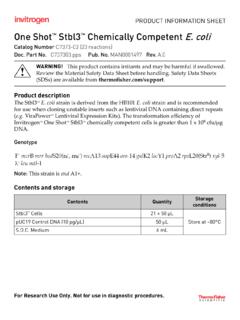Transcription of AdEasy Adenoviral Vector System - Agilent
1 AdEasy Adenoviral Vector System Instruction Manual Catalog #240009 ( AdEasy Adenoviral Vector System ) #240005 (pAdEasy-1 Vector ) #240006 (pShuttle Vector ) #240007 (pShuttle-CMV Vector ) #240008 (pShuttle-CMV-lacZ Vector ) #240081 (pShuttle-IRES-hrGFP-1 Vector ) #240082 (pShuttle-IRES-hrGFP-2 Vector ) Revision D1 For Research Use Only. Not for use in diagnostic procedures. 240009-12 LIMITED PRODUCT WARRANTY This warranty limits our liability to replacement of this product. No other warranties of any kind, express or implied, including without limitation, implied warranties of merchantability or fitness for a particular purpose, are provided by Agilent . Agilent shall have no liability for any direct, indirect, consequential, or incidental damages arising out of the use, the results of use, or the inability to use this product. ORDERING INFORMATION AND TECHNICAL SERVICES Email World Wide Web Telephone Location Telephone United States and Canada 800 227 9770 Austria 01 25125 6800 Benelux 02 404 92 22 Denmark 45 70 13 00 30 Finland 010 802 220 France 0810 446 446 Germany 0800 603 1000 Italy 800 012575 Netherlands 020 547 2600 Spain 901 11 68 90 Sweden 08 506 4 8960 Switzerland 0848 8035 60 UK/Ireland 0845 712 5292 All Other Countries Please visit AdEasy Adenoviral Vector System CONTENTS Materials Provided.
2 1 Storage Conditions .. 1 Additional Materials Required .. 2 Notices to Purchaser .. 2 Introduction .. 3 Overview of the AdEasy System .. 4 Advantages of Recombinant Adenovirus for Gene Expression .. 4 Vector Features .. 6 pAdEasy-1 Vector Map .. 7 pShuttle Vector 8 pShuttle-CMV Vector Map .. 9 pShuttle-IRES-hrGFP-1 Vector Map .. 10 pShuttle-IRES-hrGFP-2 Vector Map .. 11 pShuttle-CMV-lacZ Vector Map .. 12 Recommended Primer Sequences .. 13 Features of Bacterial Strains .. 13 Generating AdEasy Recombinants .. 14 Cloning Considerations .. 14 Cloning the Gene of Interest .. 16 Transformation Guidelines for BJ5183 Cells .. 16 Cotransforming the BJ5183 Cells to Produce Recombinant Ad plasmid .. 17 Testing Colonies for Recombinant Ad plasmid .. 18 Interpretation of Results .. 19 Amplifying Recombinant Ad plasmid .. 20 Transformation Guidelines for XL10-Gold Cells .. 20 XL10-Gold Transformation Protocol.
3 21 Preparation of Primary Adenovirus Stock with Recombinant Ad plasmid .. 23 Safety Considerations .. 23 Description of AD-293 Cells .. 23 Preparing AD-293 Cells for Transfection .. 24 Transfecting AD-293 Cells .. 24 Preparing the Primary Viral Stocks .. 26 Guidelines for Infection Conditions and Amplification of the Primary Viral Stock .. 27 Titer Considerations .. 27 Amplification Guidelines .. 27 Infection Procedure Guidelines .. 27 Optimizing Infection Conditions .. 28 Monitoring the Infection .. 28 Detection of hrGFP .. 28 Monitoring Transfection and Infection of Cells .. 28 Specifications for hrGFP and EGFP Excitation and Emission Spectra .. 29 LacZ Control: Detection and Applications .. 29 Transfection Control .. 29 Virus Control .. 29 Appendix: Plaque Assay using Agarose Overlay .. 30 Preparing Viral Stock Dilutions .. 30 Overlaying the Infected Cells with Agarose.
4 30 Plaque isolation .. 31 Troubleshooting .. 32 Preparation of Media and Reagents .. 33 References .. 35 Endnotes .. 35 MSDS Information .. 35 AdEasy Adenoviral Vector System 1 AdEasy Adenoviral Vector System MATERIALS PROVIDED AdEasy Adenoviral Vector System (Catalog #240009) Materials Provided Quantity pAdEasy-1 Vector (Catalog #240005; 100 ng/ l in TE buffer) g pShuttle Vector (Catalog #240006; 1 g/ l in TE buffer) 20 g pShuttle-CMV Vector (Catalog #240007; 1 g/ l in TE buffer) 20 g pShuttle-CMV-lacZ control Vector (Catalog #240008; 1 g/ l in TE buffer) 10 g BJ5183 electroporation competent cellsa (Catalog #200154) 5 100 l (Clear tubes) XL10-Gold ultracompetent cellsb (Catalog #200314) 5 100 l (Gold tubes) XL10-Gold -mercaptoethanol mix ( -ME) 50 l pUC18 DNA control plasmid ( ng/ l in TE bufferb) 10 l a Each 100 l aliquot is sufficient for two transformations.
5 B Each 100 l aliquot is sufficient for one transformation. pShuttle-IRES-hrGFP-1 (Catalog #240081) Materials Provided Quantity pShuttle-IRES-hrGFP-1 Vector (1 g/ l in TE buffer) 20 g pShuttle-IRES-hrGFP-2 (Catalog #240082) Materials Provided Quantity pShuttle-IRES-hrGFP-2 Vector (1 g/ l in TE buffer) 20 g STORAGE CONDITIONS AdEasy Vectors: 20 C Competent Cells (including -ME mix and pUC18 control plasmid ): 80 C Place cells at 80 C immediately upon arrival. Do not place cells in liquid nitrogen. Revision D1 Agilent Technologies, Inc. 2007-2016 2 AdEasy Adenoviral Vector System ADDITIONAL MATERIALS REQUIRED Pac I restriction enzyme Pme I restriction enzyme Alkaline phosphatase, molecular biology grade Chloroquine ViraPack Transfection Kit [ Agilent Catalog #200488] StrataPrep PCR Purification Kit [ Agilent Catalog #400771] Electroporation cuvettes, cm gap Electroporator 14-ml BD Falcon polypropylene round-bottom tubes (BD Biosciences Catalog #352059) 5-ml BD Falcon polystyrene round bottom tubes (BD Biosciences Catalog #352054) AD 293 cells (recommended) [ Agilent Catalog #240085] or HEK293 cells Growth medium for AD-293 cells [Invitrogen Life Technologies (Gibco) Catalog #11995] SeaPlaque agarose [FMC Corporation] NOTICES TO PURCHASER AdEasy products are sold under license from Johns Hopkins University.
6 Rights to use these products are limited to non-commercial research only. No other rights are conveyed. Inquiry into the availability of a license to broader rights or the use of these products for commercial purposes should be directed to Johns Hopkins University School of Medicine Office of Technology Licensing, 111 Market Street, Suite 906, Baltimore, MD 21202. Purchase of these products does not grant rights to : (1) offer the vectors or any derivatives thereof for resale; or (2) to distribute or transfer the Vector or any derivative thereof to third parties. Use of this product, licensed from Transgene SA, is covered by US Patent 7,067,310 and equivalents, as is for Research Use Only. Any commercial license request shall be directed to Transgene SA, Corporate Development, 11 rue de Molsheim, 67000 Strasbourg, France.
7 See Preparation of Media and Reagents. AdEasy Adenoviral Vector System 3 INTRODUCTION Recombinant adenoviruses are a versatile tool for gene delivery and expression. Several features of adenovirus biology have made such viruses the vectors of choice for certain applications. For example, adenoviruses are capable of infecting a broad range of cell types and infection is not dependent on active host cell division. Additionally, high virus titers and high-level gene expression can be obtained, which are important considerations for protein production techniques in mammalian cells. The most commonly used Adenoviral Vector is human adenovirus serotype 5, which is rendered replication defective by the deletion of the E1 and E3 genes. The E1 gene is essential for the assembly of infectious virus particles and is complemented in vivo by an adenovirus packaging cell line ( AD-293).
8 The E3 gene encodes proteins involved in evading host immunity and is dispensable. Not only do these deletions render the virus incapable of replicating itself, but they also create space for up to kb of foreign Two methods have traditionally been used to generate recombinant adenoviruses. The first involves direct ligation of the gene of interest into the Adenoviral genome. Because the adenovirus genome is large (36 kb) and contains few useful restriction sites, this method is technically very challenging. The second, and more commonly used method, involves cloning the gene of interest into a shuttle Vector and transferring the gene into the adenovirus genome by means of homologous recombination in an adenovirus packaging cell The isolation of recombinant adenovirus by this method involves performing multiple plaque isolations and is extremely laborious and time consuming.
9 More recently, a different approach has been developed by He and Employing the efficient homologous recombination machinery in E. coli, a recombinant adenovirus is produced by a double-recombination event between cotransformed Adenoviral backbone plasmid Vector , pAdEasy-1, and a shuttle Vector carrying the gene of interest. This eliminates the need to manipulate the large adenovirus DNA molecule in vitro (in restriction and ligation reactions). There is no need to carry out laborious plaque purification rounds. The time needed to generate a recombinant adenovirus is reduced by several weeks. Note The AdEasy XL Adenoviral Vector System is also available ( Agilent Catalog #240010). The XL kit includes BJ5183 cells pre-transformed with the pAdEasy-1 plasmid (BJ5183-AD-1 cells), providing a streamlined recombinant Ad DNA production method.
10 This kit also includes the AD-293 cells recommended for use with the AdEasy Vector System . 4 AdEasy Adenoviral Vector System Overview of the AdEasy System A schematic overview of the production of recombinant adenovirus is shown in Figure 1. In the AdEasy System , the DNA of interest is cloned into any of the four shuttle vectors (pShuttle-CMV, pShuttle, pShuttle-IRES-hrGFP-1 (Catalog #240081) or pShuttle-IRES-hrGFP-2 (Catalog #240082). Once constructed, the shuttle Vector is linearized with Pme I and cotransformed into BJ5183 together with pAdEasy-1, the supercoiled viral DNA plasmid . Transformants are selected for kanamycin resistance, and recombinants are subsequently identified by restriction digestion. Once a recombinant is identified, it is produced in bulk using the recombination-deficient XL10-Gold strain.)
